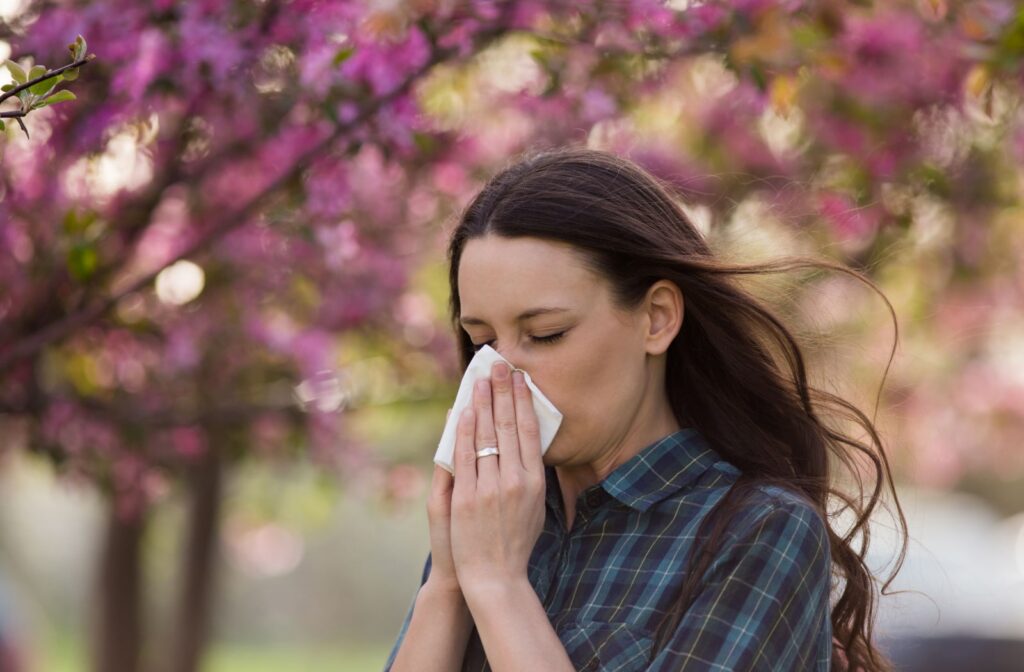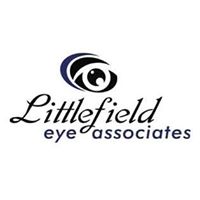Dry eyes don’t feel great and can cause considerable discomfort for many people. While there are numerous potential causes of dry eyes, one factor that may contribute to this condition is allergies.
Exposure to an allergen, such as pollen or pet dander, may produce an inflammatory response in the body. This inflammation can affect the tear ducts and interfere with the production of tears, leading to dry eyes.
If you experience dry eyes and suspect allergies, speak to your eye doctor to find ways to relieve your symptoms.
What Is Dry Eye Disease?
Dry eye disease is an eye condition that occurs because the eyes don’t produce enough quality tears or tears evaporate too quickly, leading to dryness and discomfort. Tears are essential for maintaining healthy eyes, as they provide moisture and nutrients and help to wash away debris and bacteria.
Symptoms of Dry Eye Disease
When you have dry eye disease, you may experience symptoms such as:
- Burning or stinging in the eyes
- Redness or irritation
- Sensitivity to light
- Blurry vision
- Difficulty wearing contact lenses
- Excessive tearing
Regular eye exams can help you identify the underlying cause of your dry eyes and determine the appropriate treatment options.
Causes of Dry Eye Disease
There are several potential causes of dry eye disease, either from decreased tear production or increased evaporation from an imbalanced tear film. The normal tear film contains water, oil, and mucin, but an imbalanced tear film can lead to poor-quality tears.
Causes of decreased tear production can result from the following:
- Age-related changes
- Certain medications (including allergy medications)
- Medical conditions
- Hormonal changes
Causes of increased tear evaporation can include the following:
- Meibomian gland dysfunction
- Digital eye strain
- Eyelid problems
- Environmental factors
- Vitamin A deficiency
- Eye allergies
Allergies & Dry Eye Disease
Many different types of allergies can cause dry eye as the body’s immune response to allergens can lead to inflammation that affects the tear ducts and interferes with tear production. Some of the most common allergens that can lead to dry eye include:
- Outdoor allergens: Pollen from grass, trees, and weeds
- Indoor allergens: Pet dander, dust mites, and mold
- Irritants: Cigarette smoke, perfume, skincare products, and diesel exhaust
In addition, while allergy medications like antihistamines help to alleviate allergic symptoms, they can also contribute to dry eye by reducing tear production.
Symptoms of Dry Eye Caused by Allergies
You may experience allergies year-round or seasonally. Dry eye and allergies have similar symptoms, but allergies can present with the following symptoms:
- Itchiness
- Redness
- Watery eyes
- Burning
- Eyelid swelling
- Sensitivity to light
Treatment for Dry Eye
By working with your eye doctor, dry eye therapy can help manage your allergies and find relief from dry eyes to improve your overall eye health. Depending on the underlying cause and severity of your dry eyes, several treatment options include:
- Eye drops or artificial tears: Eye drops mimic your natural tears and can help to relieve dry eye symptoms by supporting tear production and providing moisture and lubrication to the eyes.
- Prescription eye drops: Medicated eye drops have anti-inflammatory properties that help reduce inflammation and increase tear production.
- Punctal plugs: Tiny devices inserted into your tear ducts to prevent tears from draining out of the eye. Punctal plugs can provide a temporary or semi-permanent solution to dry eyes.
- Lifestyle changes: Changes to your daily routine can also help to alleviate dry eye symptoms, such as using a humidifier to add moisture to the air or avoiding environmental triggers and allergens.
- Intense Pulsed Light: Intense Pulsed Light, or IPL, targets the inflammation that causes dry eye and reduces it, leading to a healthier ocular surface. IPL also reduces redness, stimulates the meibomian glands, and increases collagen production.
Preventing Dry Eye Caused by Allergies
If allergies are the root cause of your dry eyes, there are ways to reduce or prevent allergy symptoms and dry eyes:
- If you are taking antihistamines, you may need to stop as they can worsen dry eyes. Speak to your eye doctor about antihistamines that don’t dry out your eyes.
- Close windows in your house and car and use the air conditioning instead when pollen counts are high.
- Wear protective eyewear outside, such as sunglasses, to help keep pollen out of your eyes.
- Use a mattress cover on your bed to cut down on dust mites.
- Use a dehumidifier in high humidity conditions to help cut down on mold.
- Wash your hands after touching pets.
- Use air purifier devices in your home.
- Use artificial tears to wash away allergens and lubricate your eyes
Relief from Allergies and Dry Eyes
While dry eyes and allergies present similar symptoms, including itchiness, their discomfort can affect your daily life. But with proper care, most people can find relief and maintain good eye health.
The eye doctors at Littlefield Eye Associates can help to restore tear function and minimize symptoms if you have allergies and dry eyes. Book an appointment in Kansas City to learn more about dry eye therapy.





